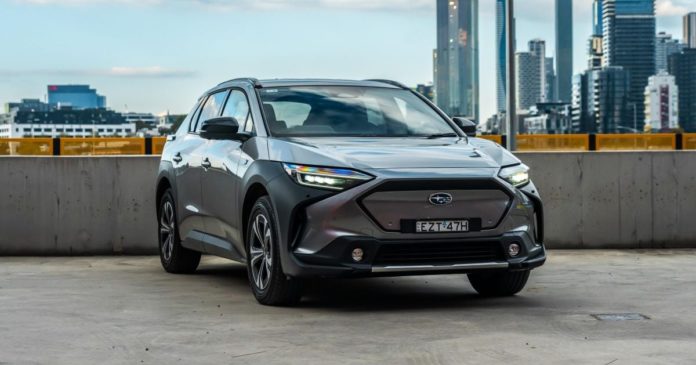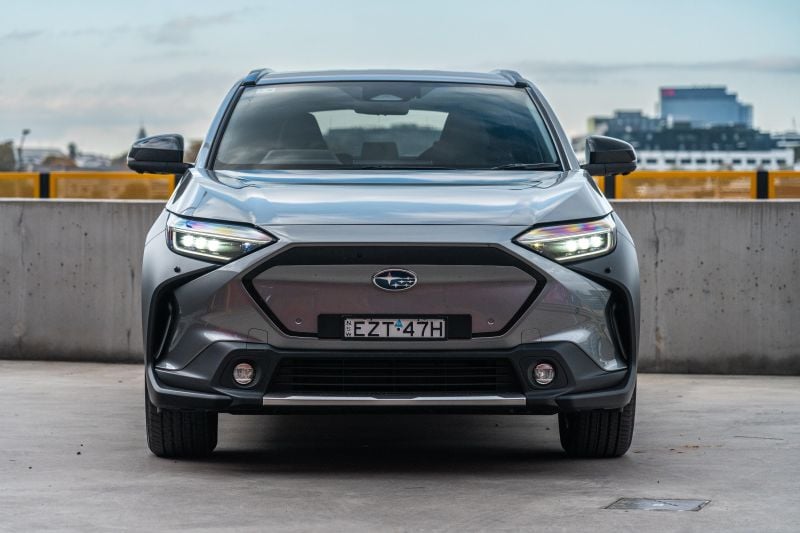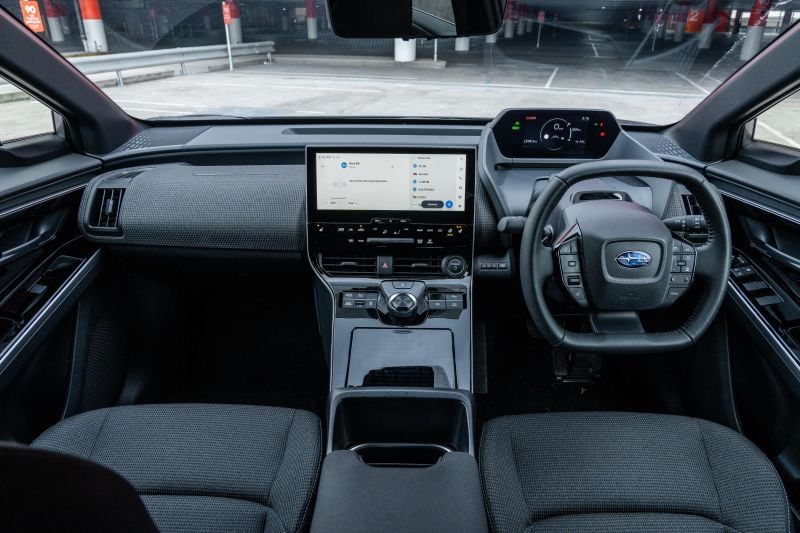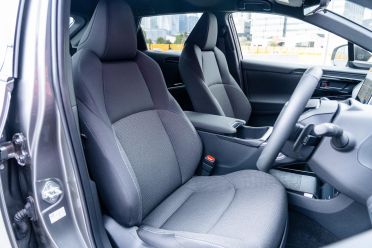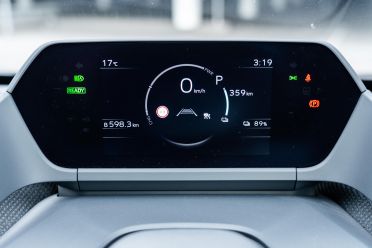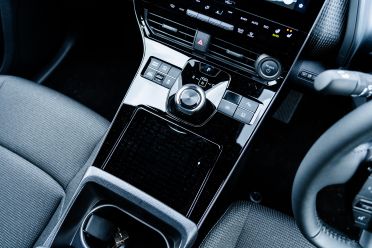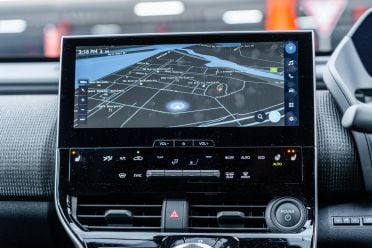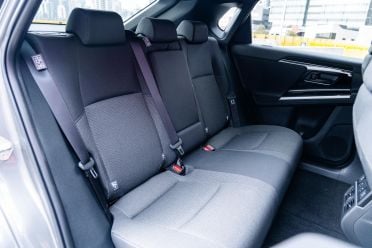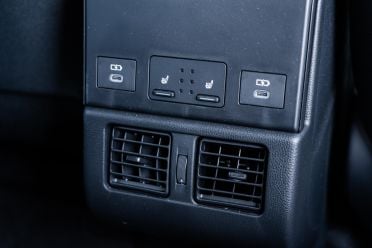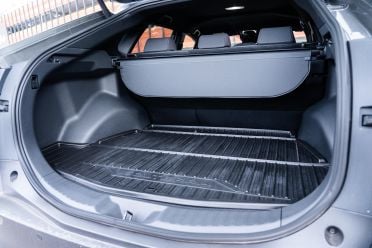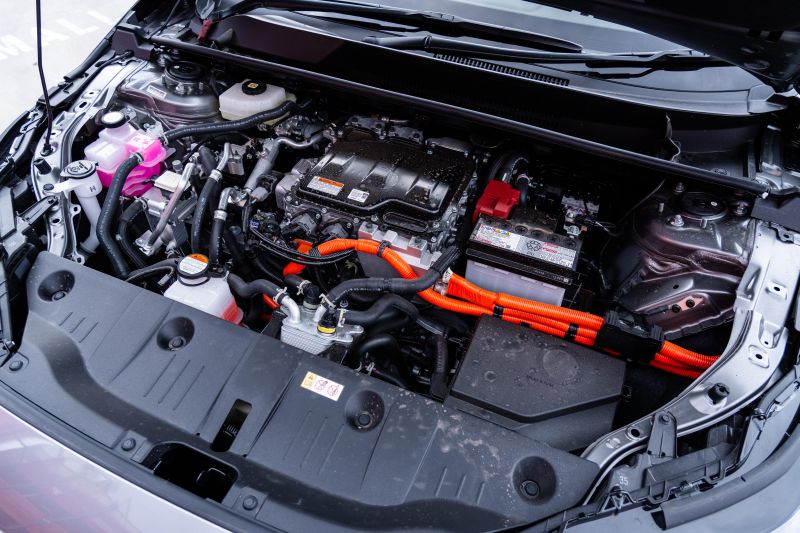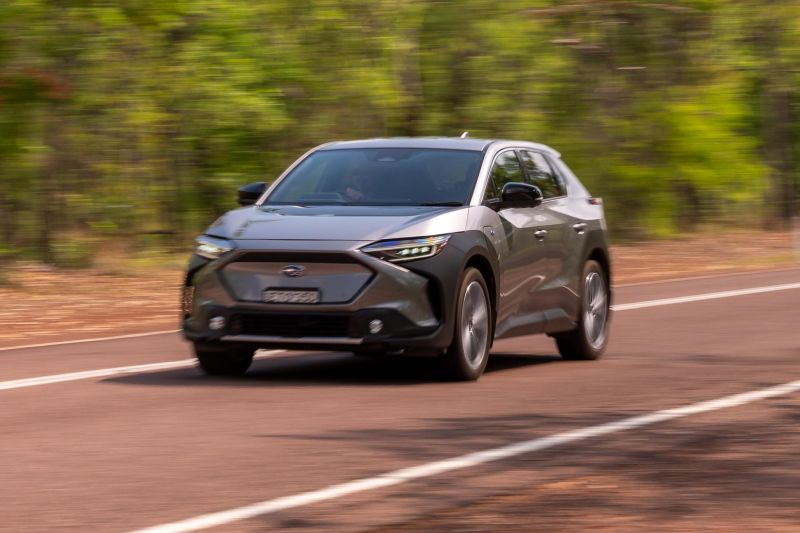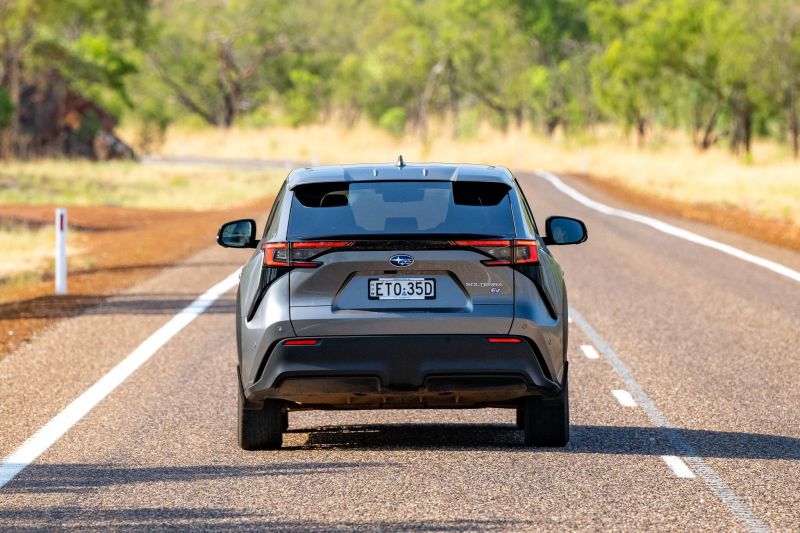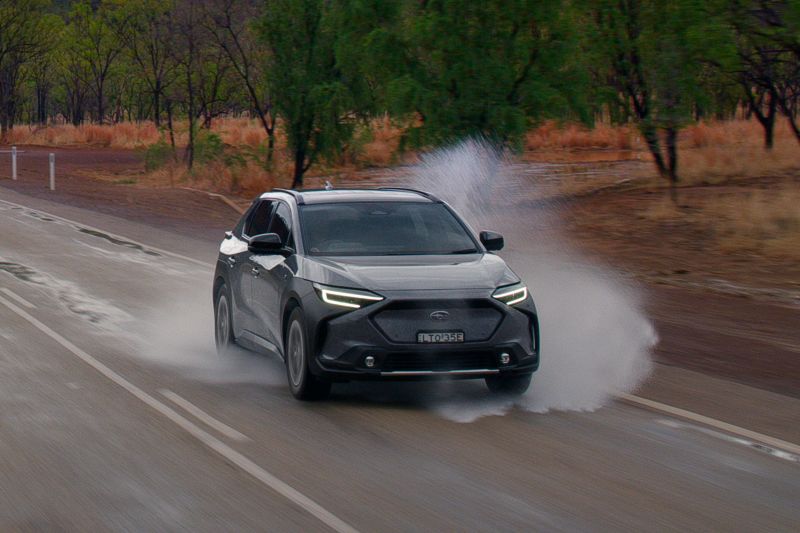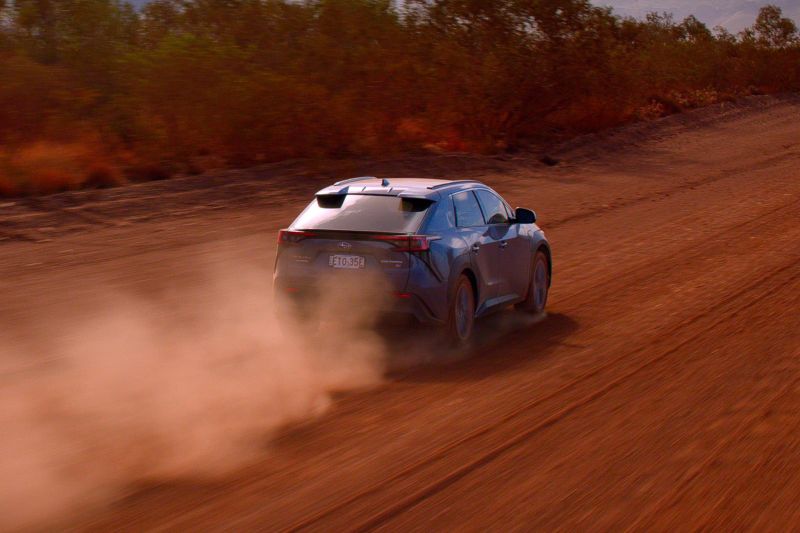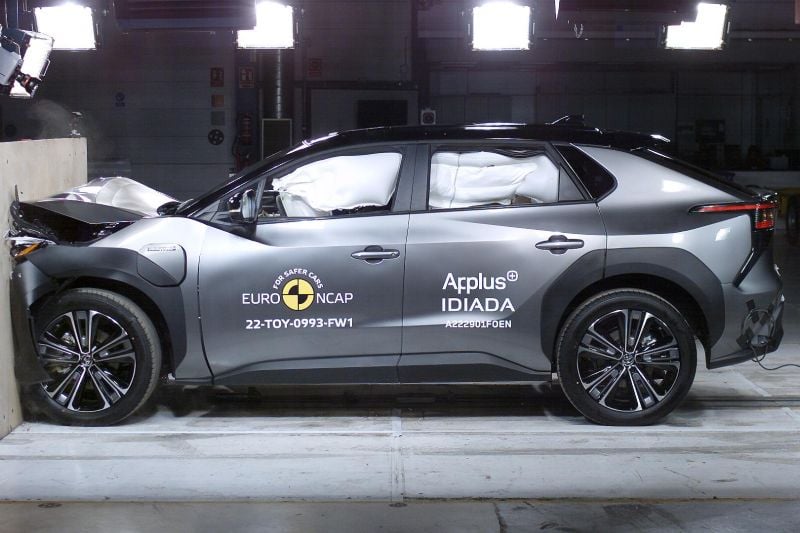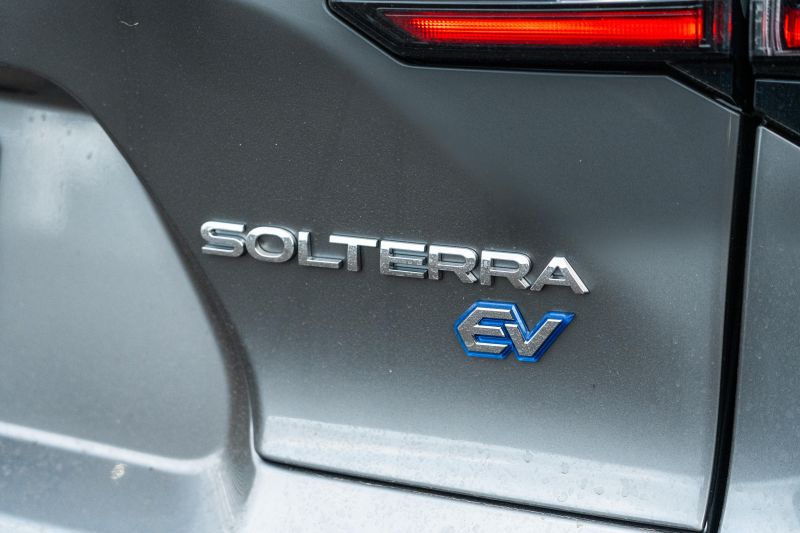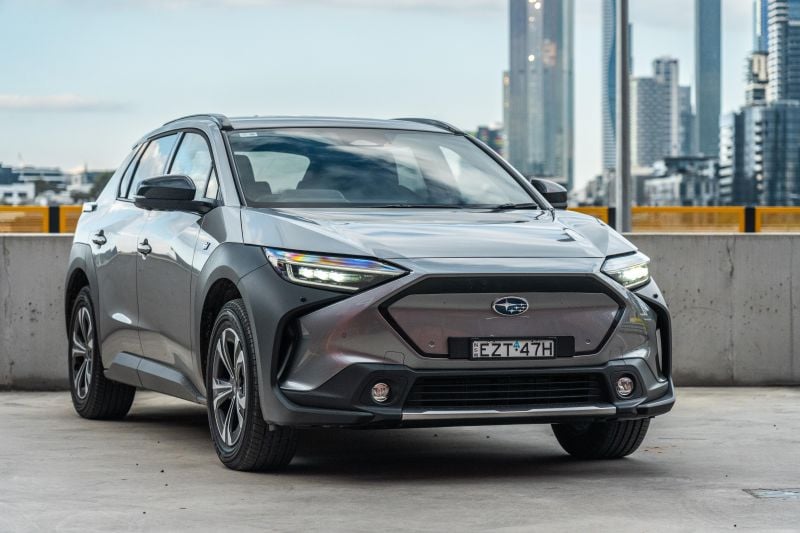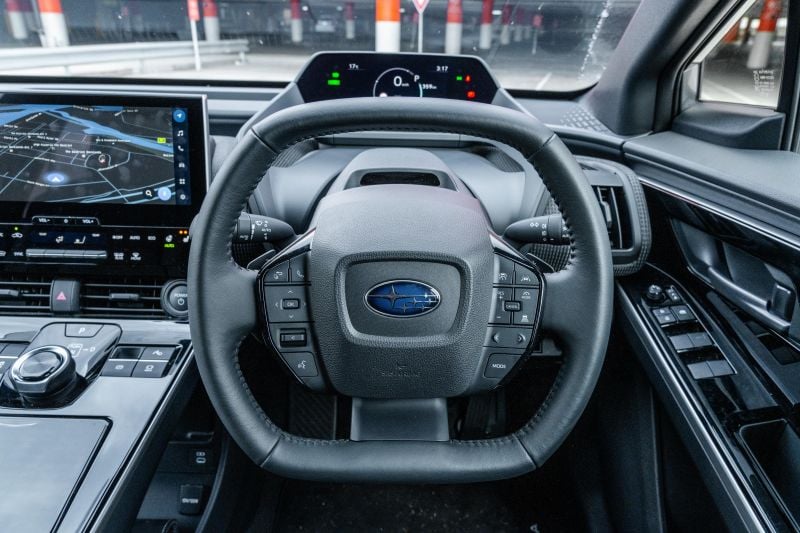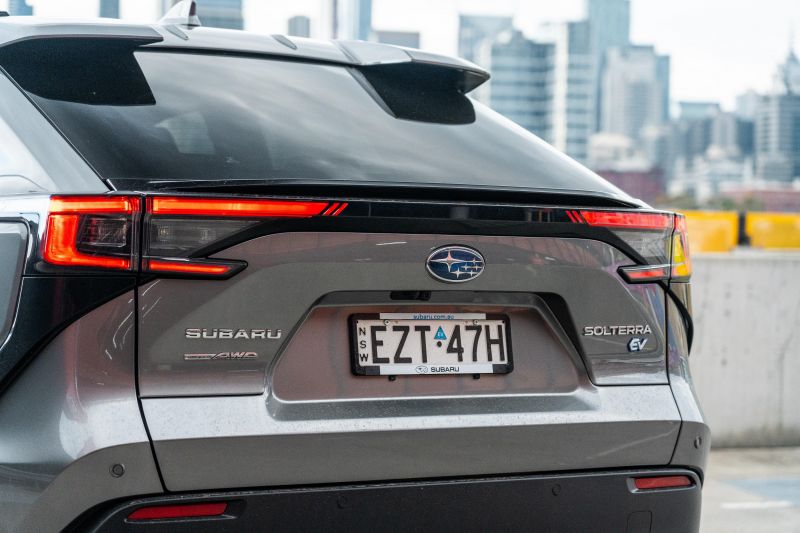Subaru is up and running in the hotly contested EV market.
The Solterra is its first electric car, and has been co-developed with Toyota. That’s why it looks very, very closely related to the bZ4X – under the skin, the pair are the same.
There are some differences between the twins, though. Along with unique styling up front, even the base Solterra gets all-wheel drive in Australia.
Subaru has also fitted equipment like blind-spot monitoring to its cheapest EV, something Toyota hasn’t.
The Solterra will need to do more than outpoint its sibling if it’s to get Subaru off to a running start in the EV wars.
It’ll also need to stand out among the a crowd including the best-selling Tesla Model Y, the retro-futuristic Hyundai Ioniq 5, and the Ford Mustang Mach-E. Does it have what it takes?
How does the Subaru Solterra compare?
View a detailed breakdown of the Subaru Solterra against similarly sized vehicles.
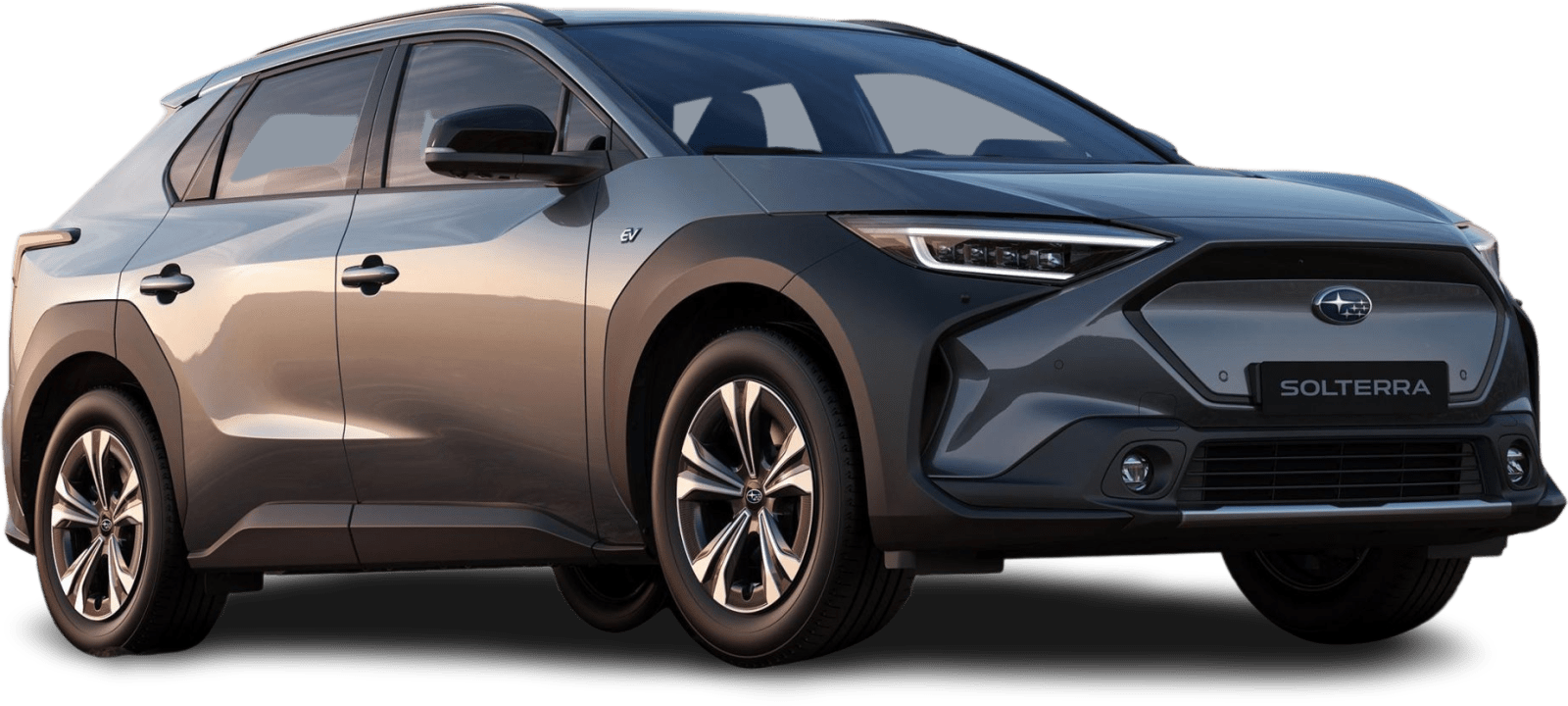
Subaru
Solterra
How much does the Subaru Solterra cost?
The base Solterra is more expensive than the base Toyota bZ4X, but it does have AWD and kit such as blind-spot monitoring – which the electric Toyota misses out on.
| Model | Price before on-road costs |
|---|---|
| 2024 Subaru Solterra AWD | $69,990 |
| 2024 Subaru Solterra AWD Touring | $76,990 |
To see how the Subaru Solterra compares with its rivals, use our comparison tool.
What is the Subaru Solterra like on the inside?
Save for the squared-off steering wheel, the Solterra is identical to a bZ4X inside.
The wide, flat central tunnel rises dramatically up to meet the dashboard, and the steering wheel is a square, almost Peugeot-ish unit sitting on a funky pod below a high-set digital instrument binnacle. Throw in the slim dashboard and low scuttle, and it’s a nice place to spend time.
The driver and passenger sit in comfortable seats packing plenty of adjustment. The cloth trim on the base model doesn’t look particularly high-end, but it’s lovely and warm on cold Melbourne mornings and actually feels quite premium.
Leaving out a wireless phone charger in the base model doesn’t feel appropriate in what’s meant to be a technology leader, though. The manually adjusted passenger seat is likely to be a non-issue for owners, but it also feels more Impreza than $70k electric hero.
There’s plenty of space for big bodies with the electrically adjustable driver’s seat set down low, and I was able to see the instrument binnacle over the low-set steering wheel thanks to its odd shape. It feels a bit weird as you pass it through your hands in tight spaces, but it does solve a problem.
The 12.3-inch touchscreen infotainment system is very good. It’s pretty to look at, responds quickly to inputs, and has a simple enough structure that owners stepping out of cars featuring much older tech won’t feel too lost.
It’s worth noting though it’s a Toyota system, which means it doesn’t look or feel anything like what you get in a new Outback or Impreza. Wireless smartphone mirroring is welcome, given the only USB ports that supports wired mirroring is an older, slower USB-A port.
The driver’s display is utilitarian, offering a clear read on your speed, range, and energy consumption… but nothing more. It works, it’s not distracting, but it’s not exactly special either.
There are dual cupholders at the base of the central tunnel, and a huge space below that floating tunnel in which you can store things. There’s also a deep bin under the padded central armrest – but a conventional glovebox under the passenger side of the dashboard is a notable omission.
Toyota told us at the bZ4X launch it had to choose between fitting a glovebox or a more efficient, radiator-style heater beneath the dashboard, and it opted for the latter. Given this is the same car, the same rationale applies.
Rear seat space is a mixed bag. Legroom is excellent, with room for my lanky 6’7 frame behind a full-sized adult’s seating position. Unlike a Model Y, the lithium-ion battery under the floor doesn’t force you into an awkward knees-up position.
Headroom isn’t all that flash, however. Between the sloping roofline and the raised rear bench, tall passengers will feel as though they’re pressed right up into the headlining.
Reclining the backrest (up to 6.0 degrees) doesn’t really help, because there’s a chunky structural beam running across the roof behind the rear headrests.
Central passengers are perched on a raised section, and need to compete with a slight hump in the middle of the floor.
It’s odd given the platform underpinning the Solterra is supposedly a dedicated electric setup, and most EVs have a flat floor.
A fold-down central armrest, air vents, and dual USB-C ports feature back there. ISOFIX points are present on the outboard rear seats, as does a trio of top tether points for child seats.
Claimed boot space is down on what you get in a Subaru Forester (498L), and you don’t get a spare wheel.
| Dimensions | Subaru Solterra AWD |
|---|---|
| Length | 4690mm |
| Width | 1860mm |
| Height | 1650mm |
| Wheelbase | 2850mm |
| Weight | 2015kg |
| Boot space (seats up) | 410L |
To see how the Subaru Solterra compares with its rivals, use our comparison tool.
What’s under the bonnet?
Unlike in the related Toyota bZ4X, there’s no front-wheel drive version of the Solterra on offer in Australia.
| Model | Subaru Solterra AWD |
|---|---|
| Drivetrain | Dual electric motors |
| System power | 160kW |
| System torque | 337Nm |
| Driven wheels | All-wheel drive |
| Battery | 71.4kWh lithium-ion |
| Tare mass | 2015kg-2060kg |
| Claimed range | 485km (NEDC) |
| Energy consumption (claimed) | 14.1kWh/100km |
| Energy consumption (observed) | 16.2kWh/100km (mixed commuting) |
| Maximum DC charging rate | 150kW |
| Charging time (10-80 per cent) | 30 minutes (approx.) |
| Maximum AC charging rate | 11kW |
| Charging time (0-100 per cent) | 6.5 hours (approx) |
| Towing capacity | 750kg (braked, unbraked) |
To see how the Subaru Solterra compares with its rivals, use our comparison tool.
How does the Subaru Solterra drive?
Smooth, quiet, and quick enough – the Solterra is inoffensive.
There’s very little groundbreaking about it, but that has a charm of its own. Anyone hopping out of a Forester or an XV/Crosstrek will need to adjust to the way it delivers its performance, but the learning curve is shallower here than in a Model Y, for example.
Put your foot down and it picks up smoothly off the line, with no scrabbling for grip thanks to the standard all-wheel drive system.
You get silent thrust, which is enough to gently squeeze you back in your seat – but not enough to make the average Impreza driver think they’ve accidentally stepped on the hyperdrive button.
The AWD drivetrain packs more of a punch than the base FWD on offer in the bZ4X, and is meaningfully more responsive than the hard-working boxer engines in most Subaru models, but it’s also pretty tame by EV standards.
Ride quality is solid around town, nicely soaking up potholes, speed humps, and roads damaged by heavy rains.
Despite its 2.0-tonne kerb weight, it doesn’t smack or slap into sharp bumps like some rivals. It’s nicely controlled, which isn’t always the case in heavy electric cars.
Regenerative braking (which harvests energy by turning the electric motor into a dynamo to slow the car, rather than using the brakes) is very gentle in the default setting, and even in its more aggressive mode necessitates you use the brake pedal.
That’ll make owners hopping out of petrol or hybrid cars feel at home, but does mean you don’t get to enjoy one-pedal driving like is offered in a Tesla or Hyundai Ioniq 5 – the option for even more aggressive regen would be welcome.
At higher speeds, the Solterra settles nicely into a cruise. Ride quality remains excellent at 100km/h on average Australian highways, and the suspension has been smartly tuned to effectively keep the car’s 2.0-tonne mass in check.
It’s nicely controlled over big country crests, and doesn’t bounce or bob around like a boat through big dips in the road.
We recently found the Hyundai Kona Electric, for example, struggled to keep itself in check on our high-speed test road at Lang Lang; the bZ4X we drove there didn’t get out of shape in the same way, despite its hefty kerb weight.
There’s even a bit of fun to be had on sweeping roads, provided you keep the fact this is a big, heavy car in mind. One of the downsides of going electric however, is the fact there’s no petrol engine to drown out road noise at higher speeds.
You notice road roar from the coarse-chip highways common in rural Australia at 100km/h more here than in a RAV4, which may have drivers upping the stereo volume by one or two notches.
The upside though, is you have plenty of punch under your right foot to overtake at highway speeds – meaning you don’t need a run-up to pass trucks on undivided country highways, which is a common complaint in the Forester or non-turbo Outback.
The driver assists are excellent, although they do look and feel a bit different to the camera-based EyeSight systems in the broader Subaru range.
The adaptive cruise is smooth and smart, the lane-keeping assist only intervenes when it’s actually necessary, and the lane-centring doesn’t want to rip the wheel out of your hands. Subaru includes blind-spot monitoring in the base model, which Toyota doesn’t.
Our launch drive of the Solterra included a stint on a reasonably rugged fire trail, which isn’t particularly common in the EV world.
Along with unique tuning to the throttle and traction control, you’re able to set the Solterra in X-Mode. The graphic and name are pure Subaru, and even Toyota admitted Subaru’s expertise was key to making the system work.
Set your speed, and it will maintain it on tricky surfaces – and it worked over some loose, rocky tracks. Likewise hill descent control.
Motor control is excellent, with almost no slipping or scrabbling from the tyres, and the 212mm of ground clearance on offer is on a par with a Subaru Outback. Will owners ever actually do this? Unlikely – but the option is there…
What do you get?
There are just two trim levels available, and the AWD is the base model.
Solterra AWD highlights:
- 18-inch alloy wheels
- Tyre repair kit
- Rear privacy glass
- 2kW AC charging cable
- Power-folding exterior mirrors
- Automatic self-levelling LED headlights
- Adaptive high-beam
- Puddle lights
- Rain-sensing wipers
- Power tailgate
- Keyless entry, start
- Electronic parking brake
- Dual-zone climate control
- Tilt, telescopic steering wheel adjustment
- 12.3-inch touchscreen infotainment system
- Satellite navigation
- Wireless Apple CarPlay, Android Auto
- 7.0-inch digital cluster
- 6-speaker sound system
- DAB+ digital radio
- 2 x front USB-C outlets
- 1 x front USB-A outlet
- 2 x rear USB-C outpets
- Digital rear-view mirror
- Leather-wrapped steering wheel
- Heated steering wheel
- Cloth upholstery
- 8-way power driver’s seat
- Heated front seats
- Heated outboard rear seats
- Reclining rear bench
Is the Subaru Solterra safe?
The Solterra has a five-star ANCAP safety rating, based on testing conducted by Euro NCAP on the bZ4X in 2022.
It received an adult occupant protection rating of 88 per cent, a child occupant protection rating of 88 per cent, a vulnerable road user protection rating of 79 per cent, and a safety assist rating of 93 per cent.
Standard safety equipment includes:
- Adaptive cruise control
- Autonomous emergency braking
- Blind-spot monitoring
- Driver attention monitoring
- Emergency Steering Assist
- Lane Tracing Assist (lane centring)
- Parking Support Brake
- Rear cross-traffic alert
- Safe Exit Assist
- Surround-view camera
- Traffic sign recognition
- Tyre pressure monitoring
- Front and rear parking sensors
- Front, front-side, curtain and front-centre airbags
How much does the Subaru Solterra cost to run?
The Solterra is backed by a five-year, unlimited-kilometre vehicle warranty; plus an eight-year or 160,000km battery warranty.
Subaru is offering free servicing for the first five years or 75,000km – with intervals of 12 months or 15,000km. There’s also five years of roadside assistance.
The company is offering a choice of either an Ocular LTE single-phase 7kW Type 2 wallbox for $2250 including installation, or a three-phase 22kW unit for $2645.
CarExpert’s Take on the Subaru Solterra
The Solterra, like the related bZ4X, isn’t going to blow you away with its new-age design or drive.
It will, however, make anyone looking for their first electric car having hopped out of a Forester feel pretty comfortable. If only Subaru had tuned in a Boxer startup noise…
There’s polish to the way it drives, the interior blends easy-to-use elements from the Toyota world with a modern and interesting layout, and the rear seats make it a practical enough family car. We’d love a bit more boot space, though.
The Solterra does have a point of difference from the related bZ4X, and that’s the fact it’s offered with AWD at the base level.
It’s a nod to the traditional Subaru buyer, and makes the Solterra a compelling alternative to its Toyota twin if you’re attracted to their no-nonsense brand of electric motoring.
It’s the variant I would buy, given none of the equipment on the Touring is essential.
Just beware, there are more exciting options out there if you want the electric revolution to look and feel a bit more… revolutionary.
Click the images for the full gallery
MORE: Buy a Subaru Solterra
MORE: Everything Subaru Solterra

